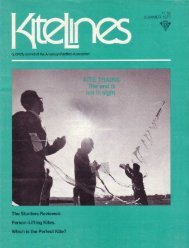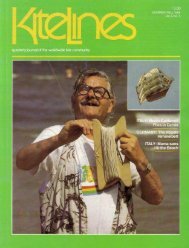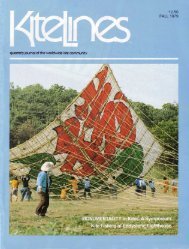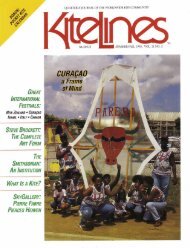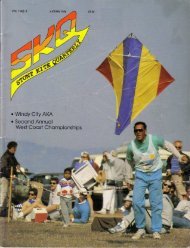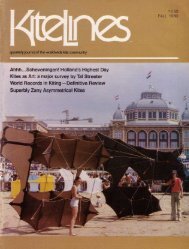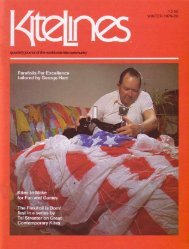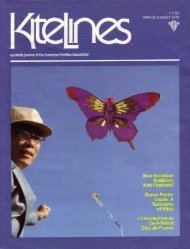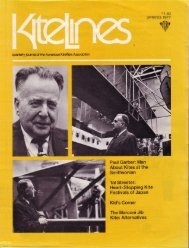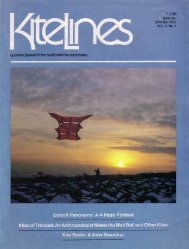Create successful ePaper yourself
Turn your PDF publications into a flip-book with our unique Google optimized e-Paper software.
Mylar Star Hearing(Continued from page 68)occurred on April 16th of this year in LosAngeles . . . I think that what that incidentdemonstrates is that if the child had been flyingan aluminized kite, the power lines would havefallen on him and he would have been killed .He would have been killed in any case .Second, MY. Alonso has stated that he wishesthe Commission to do more than make a findingwith respect to his aluminized kites . Hewants standards set for kites in general .This, however, is not a proceeding to setstandards for kites . This is a proceeding underSection 15 of the Consumer Product SafetyAct to determine whether specific kites, thealuminized kites that respondent manufactured,present a substantial producthazard . . .In 20th Century society, the kiteflier is exposedto a source of electricity in even the bestof weather, Overhead electrical power linescarrying as much as 12,000 volts of electricityare found in most residential areas . Indeed,several sets of power lines are attachedparallel to each other on poles . <strong>Kite</strong>s frequentlybecome entangled in power lines, and therecord in this case shows that when an aluminizedkite contacts overhead power lines, alethal shock hazard exists .There are several ways in which an aluminized)kite that comes in contact with powerlines can present a hazard . First, there is aline-to-ground hazard . If a kite with a longtail gets caught in an energized power line, aperson who grabs the tail of the kite, forexample a child attempting to retrieve it, asthat child attempted to retrieve his kite onApril 16th, will complete an electrical circuitto the ground . This circuit will carry a lethaldose of electricity through his body .Second, there is a line-to-line hazard . If analuminized kite comes into contact with a pairof power lines, an arc carrying sufficient currentto break through the lines and cause themto fall will result, can result .Third, if the top level high voltage powerlines fall onto the lower level lines rather thanfalling onto the ground, a high voltage powersurge can be transmitted into residencescreating a risk of fire as well as shock toinhabitants .Thus aluminized kites present a hazard notonly to kitefliers, but also to passers-by andeven to stay-at-homes .The record in this proceeding demonstratesthat the types of hazards I have outlined canand do occur in real life . In early April, 1975,at Herman Street in San Francisco, an aluminizedkite caused power lines to fall on a car,resulting in damage to both the vehicle and thetires . The car was retrieved from the fallenpower lines by utility company repairmen .Fortunately, no one was injured .On April 15th,. 1975, at Jackson and BroderickStreets, also in San Francisco, an aluminumkite got away from its owner, lodged inthe power lines, and caused a power surge tohouses in the neighborhood . The surge hadrepercussions in at least three houses . Itcaused a fuse box to explode and burn, anoverhead chandelier to shatter, and a refrigeratorcompressor to break . Again, fortunately,no one was injured . but the possibilities forinjury are obvious . . .Respondent has correctly pointed out thatthe arc in the tests self-extinguished withoutcausing the lines to break . He argues thatthis proves that the kites are not hazardous,but the test did show that the kite conductedan enormous amount of electricity, and breakageis possible, as testified to at the hearingby both John Thurber, Commission staff engineer,and Professor Charles Delziel, ProfessorEmeritus of electrical engineering atthe University of California at Berkeley . . . .More importantly, the fact that aluminum kiteshave caused power lines to break and fall wasestablished at the hearing by utility companyforeman Ira Bray and by consumer witnessJeanne Sullivan, and indeed the fact that thepower lines did not break in the test does notprove that they would not do so in real life .The power lines in the test were six feet apart .Power lines in San Francisco are a minimumof 1 1 and a half inches apart, as John Thurberstated at the hearing . An even hotter arc, onemore likely to break the power lines, wouldhave resulted if the lines in the test had beencloser together as they are in real life .This brief summary of the record demonstratesthe product defect which the staffbelieves and the presiding officer properlyfound to present a substantial product hazard .Aluminized kites are highly conductive ofelectricity. Their electrical conductivity is aI completelyagree that thereneeds to bea uniformrequirementon kites .property which presents an unreasonable riskof serious injury, lethal shock to the public .This risk of injury is patently unnecessary in arecreational novelty item such as a kite . <strong>No</strong>such risk is presented by conventional paperkites or by non-aluminized polyester film kitesin their originally manufactured state .Respondent's argument that conventionalkites also are hazardous if flown with wet tailsor with metallized strings injects a new issuewhich is irrelevant to this proceeding . We agreethat the situations hypothesized by respondentalso are dangerous, but the hazards presentedby such misused kites result from alterationsperformed by the kiteflier using products whichare fit for their originally intended purpose .In contrast, the defect in respondent's aluminizedkites is manufactured into the productby respondent himself . The product defectthat we have described, that is, the electricalconductivity of the kites, presents a risk ofinjury that is substantial as that term is definedin Section 15 of the Consumer ProductSafety Act .The statue states that a substantial producthazard may be shown in a variety of ways :first, by the pattern of the defect : second, bythe number of defective products distributedin commerce : third, by the severity of the risk,or fourth, otherwise . If a product meets anyone of these statutory criteria, that is enoughto establish a substantial product hazard .Aluminized kites fit into all four categories . . .The evidence compels the conclusion that thekites present a substantial product hazardand we urge the Commission to so find . . .At the hearing, testimony from Pacific Gasand Electric Company, Ira Bray, establishedthat PG&E's parallel high voltage lines are aminimum of 11 and a half inches apart, andthat an aluminized kite whose dimensionsexceed 11 and a half inches presents a lineto-linehazard because it can fuse two linesand initiate an arc and cause the lines to fall .On the basis of Mr. Bray's testimony, thestaff moved to amend the notice of enforcementto include the allegation that respondent'stailless winged box kites approximately 36inches by 28 inches ., and tailless diamondfighter kites, approximately 25 inches by 31inches, also present a substantial producthazard . . .Although respondent did not object at thehearing to the amendment, he has argued inhis brief that it is unfair to require him to recalltailless box and fighter kites when other companiesconcerned, agreements have beenordered to recall only their dragon kites withtails . He argues essentially that the orderissued against him should coincide with thoseagainst the consenting respondents, but aconsent order does . not have the precedentvalue of a litigated case ., and the relief accordedto the public in a consent order cannot limitthe relief to be accorded by an order issuedafter a matter has been tried, Respondentrejected the opportunity to sign an identicalconsent agreement, and choose instead toundergo the hazards of a hearing . He thereforeshould not now be heard to complain that thehearing in which he alone participated led toan inequitable result .Section 15C empowers the Commission toorder notification to individual members ofthe public through the mails and to the generalpublic through the print and broadcast media .In this case, general as well as individual noticeis necessary . . . to inform kitefliers to stopusing the kites because they are dangerous,but the hazard presented by aluminized kitesis so substantial that notice to the public ingeneral and to Mylar Star kitefliers in particularis not sufficient to eliminate the danger .The most certain way to remove the danger isto recall the kites . We believe that the publicinterest requires recall and that recall mustinclude provision for the return of the kites aswell as their replacement . . .Commissioner Kushner : Does enforcementcounsel, is enforcement counsel able to distinguishthe degree of hazard or degree ofrisk associated with aluminized kites havinglong tails and those that don't have long tails?Ms . Rubenstein : Well, there is one distinction .The kites with the long tails present an extrahazard . It is only kites with the long tails thatpresent the hazard of dangling from the line tothe ground . The kites without tails don't presentthat one .Commissioner Kushner : Do I infer then thatyou regard the kites having long tails as presentinga greater degree of risk than thosewithout the tails?Ms . Rubenstein : Well, yes, in the sense thatrisk can occur more than one way, but I regardthe kites without tails as presenting a greatdegree of risk also,Commissioner Kushner: I am not sure whether



